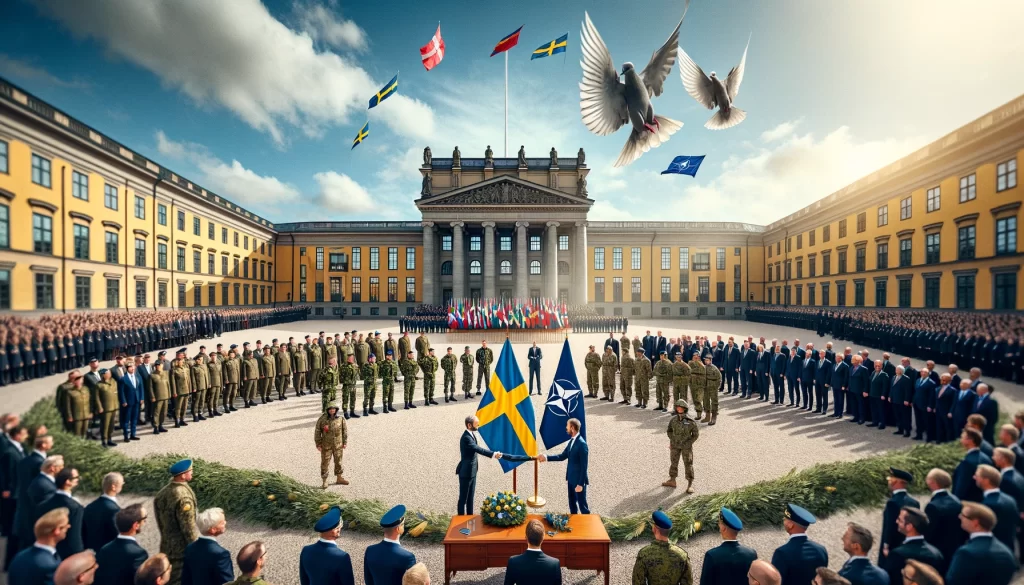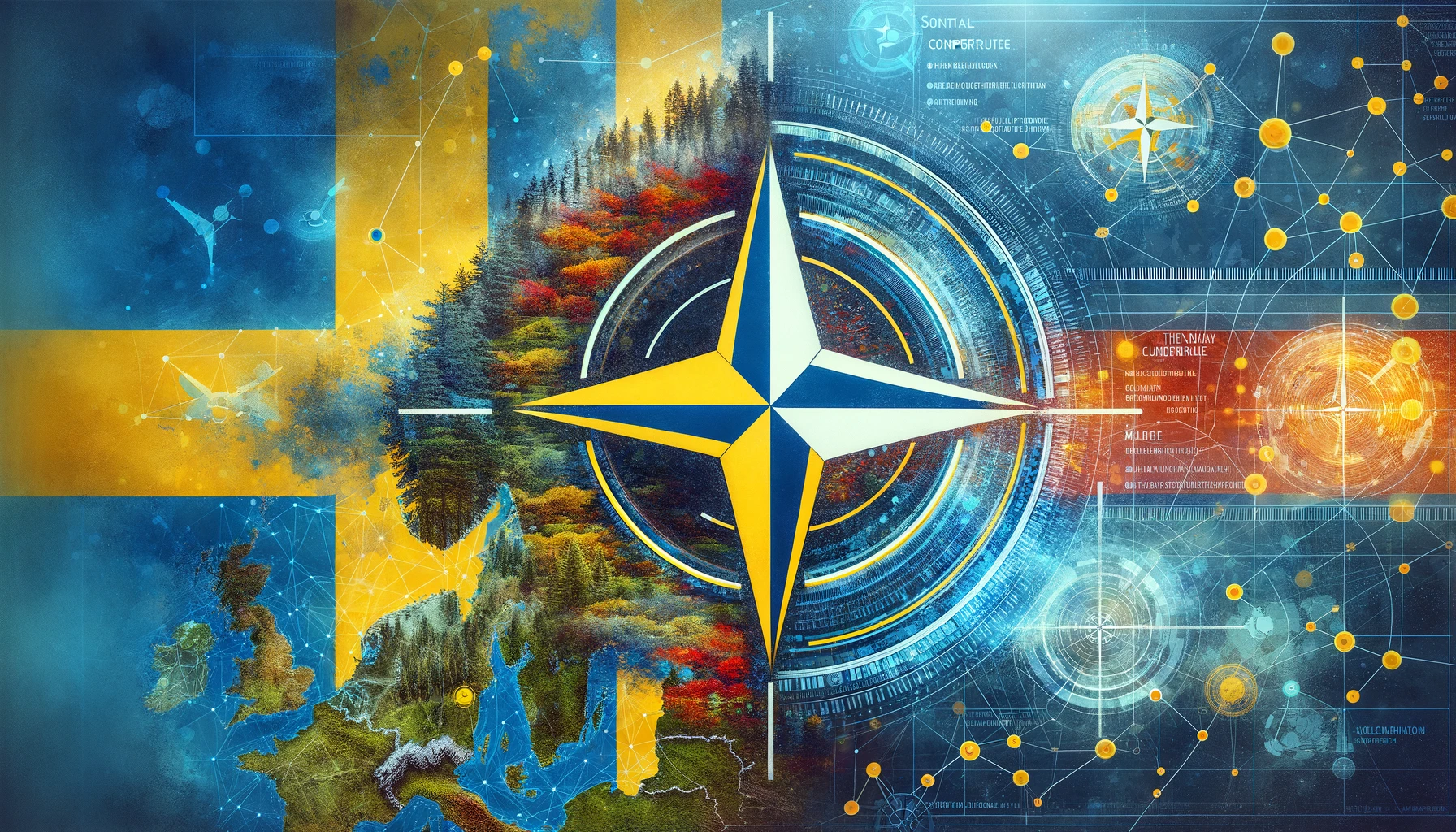In a momentous event that signals a major transformation in European security dynamics, Sweden officially became a member of the North Atlantic Treaty Organization (NATO) on Thursday. This move is particularly significant as it underscores the unintended consequences of Russian President Vladimir Putin’s actions in Ukraine, reshaping the security landscape in a way he likely did not anticipate.
The ceremonial final step of Sweden’s accession took place in Washington, where Swedish Prime Minister Ulf Kristersson handed over the necessary documents to U.S. Secretary of State Antony Blinken, making Sweden the 32nd member of NATO. This follows the inclusion of Sweden’s neighbor, Finland, into the alliance the previous year.
Putin had previously justified his military actions in Ukraine by expressing concerns over NATO’s expansion. Ironically, his aggression has led to a stronger and larger NATO alliance at Russia’s doorstep, a development that Russia will have to contend with for many years to come.
During the meeting, Blinken highlighted the strategic miscalculation made by Russia through its aggression in Ukraine, which, rather than averting, has hastened the very outcomes Putin sought to prevent. This includes the bolstering of NATO’s strength and unity.
The addition of Sweden (and Finland) to NATO is strategic, enhancing the alliance’s capabilities in the far north, an area of significant military importance for Russia, and around the Baltic Sea, especially near the Russian exclave of Kaliningrad. Sweden’s expertise in naval operations in Baltic waters and its air capabilities will significantly improve NATO’s ability to support and defend its Baltic member states if necessary. Furthermore, Sweden has committed to deploying troops to join a multinational force in Latvia, reinforcing the alliance’s presence in the region.

NATO Secretary General Jens Stoltenberg and Prime Minister Kristersson have both emphasized the enhanced security and strength that Sweden’s membership brings to both the country and the alliance as a whole. Kristersson also pledged that Sweden would meet the alliance’s defense spending target, underscoring the country’s commitment to shared security responsibilities.
Sweden’s journey to NATO membership faced obstacles, particularly from Turkey and Hungary, which had temporarily blocked its bid. However, overcoming these hurdles sends a clear message to Putin and others that attempts to influence or intimidate neighboring countries will meet with strong resistance.
Historically, Sweden maintained a policy of military nonalignment, a stance that shifted dramatically following Russia’s invasion of Ukraine in February 2022. This event awakened Europe to the need for greater security and defense preparedness, leading to increased defense spending and a reevaluation of military alliances.
NATO has since initiated its most significant strategic overhaul since the Cold War, focusing on deterring Russian aggression and ensuring the defense of alliance territories. The rapid change in public sentiment in Finland and Sweden regarding NATO membership post-invasion, and the subsequent diplomatic challenges, particularly with Turkey, underscored the complexity of expanding the alliance.
Despite these challenges, Sweden’s accession marks a pivotal shift in the security paradigm of Europe, demonstrating the alliance’s adaptability and resilience. The immediate application of NATO’s collective defense clause, known as “Article 5,” to Sweden symbolizes a profound change, ensuring that the country now enjoys the full protection and support of the alliance.
This article is based on the following article:
https://www.washingtonpost.com/world/2024/03/07/sweden-joins-nato/

Background Information
Understanding these key points helps clarify the significance of Sweden’s accession to NATO, reflecting the changing security dynamics in Europe and the ongoing challenges posed by Russia’s foreign policy actions. It marks a historical shift for Sweden, indicating a move away from its traditional stance of neutrality in response to growing security concerns in the region.
1. What is NATO?
The North Atlantic Treaty Organization (NATO) is a military alliance established in 1949, with the primary aim of safeguarding the freedom and security of its member countries through political and military means. NATO promotes democratic values and enables members to consult and cooperate on defense and security-related issues to solve problems, build trust, and, in the long run, prevent conflict. It’s based on the principle of collective defense, meaning that an attack against one or several members is considered an attack against all. This is enshrined in Article 5 of the NATO treaty.
2. Russia’s Relationship with NATO
The relationship between Russia and NATO has been complex and often strained. After the Cold War, NATO expanded eastward, incorporating several countries that were once part of the Soviet Union’s sphere of influence. Russia has viewed this expansion as a threat to its security and sphere of influence. The tension has been exacerbated by Russia’s military actions in Georgia (2008), Crimea (2014), and more recently, its full-scale invasion of Ukraine in 2022.
3. Sweden’s Military Neutrality
Sweden has a long history of military neutrality, meaning it did not join military alliances and aimed to remain neutral in conflicts. This policy was a cornerstone of Swedish foreign policy for over 200 years, particularly during the Cold War when the country chose not to align with either NATO or the Warsaw Pact (the Soviet-led Eastern bloc). However, the evolving security landscape, particularly Russia’s aggressive actions in Ukraine, has prompted a reevaluation of this stance.
4. The Strategic Importance of the Baltic Sea
The Baltic Sea is a strategic maritime region bordered by Sweden, Finland, Russia (including the Kaliningrad exclave), and several NATO and EU countries. It’s crucial for military and economic reasons, including trade routes and military access. The inclusion of Sweden (and Finland) in NATO significantly affects military strategy in this region, enhancing NATO’s ability to operate and defend these waters.
5. The Process of Joining NATO
Joining NATO requires the unanimous agreement of all existing member countries. This process involves diplomatic negotiations and, often, reforms and agreements by the aspiring member country to meet NATO standards and address the concerns of current members. Turkey and Hungary’s objections to Sweden’s membership highlighted the complexities of this process, involving issues beyond straightforward security concerns, including political disagreements and demands.
6. Collective Defense: Article 5
Article 5 is the cornerstone of the NATO alliance, stipulating that an armed attack against one or more members in Europe or North America shall be considered an attack against all members. It serves as a deterrent to potential aggressors, promising a united and powerful response to any attack on a member state. This principle has only been invoked once, in response to the September 11, 2001, terrorist attacks in the United States.
Please subscribe to Insight Fortnight, our biweekly newsletter!
